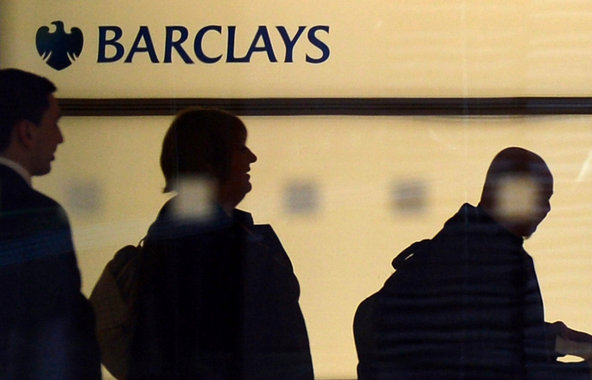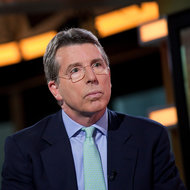 Carl Court/Agence France-Presse — Getty ImagesBarclay’s headquarters in Canary Wharf in east London.
Carl Court/Agence France-Presse — Getty ImagesBarclay’s headquarters in Canary Wharf in east London.
When Barclays bank manipulated key interest rates to bolster profits during the 2008 financial crisis, senior executives said they were following a common practice that regulators implicitly approved, according to documents released by the bank and authorities.
But the illicit acts, which led to a $450 million penalty for the bank, claimed its biggest victims on Tuesday: Robert Diamond, the British bank’s chief executive, and one of his top deputies, Jerry del Missier, the chief operating officer. The scrutiny is expected to grow on Wednesday, when Mr. Diamond appears before a British parliamentary committee.
Even as they resigned, Barclays published documents indicating that some executives thought they were responding to an implied directive from the Bank of England, Britain’s central bank.
Barclays, in its defense, said that it not only advised the Bank of England and other British authorities about interest rate discrepancies across Wall Street, but also the Federal Reserve Bank of New York. The Wall Street firms weren’t told to stop the practice, Barclays said.
The disclosures put a spotlight on the interaction between regulators and big banks over the setting of interest rates during the financial crisis, raising questions about what authorities knew about the practice.
Investigators cast some doubt on Barclays’ view. The bank never explicitly told regulators that it was reporting false interest rates that amounted to manipulation, according to regulatory documents.
“Barclays is just one example of why we need a culture shift in the financial world — and that means all the way to the top,” said Bart Chilton, a member of the Commodity Futures Trading Commission, the American regulator leading the investigation.
After the Barclays settlement, American and British authorities are now shifting their focus to a pattern of wrongdoing on Wall Street, pursuing action against more than 10 big banks scattered across the globe, including UBS, JPMorgan and Citigroup. Authorities suspect that big banks reported false rates throughout the crisis to squeeze out extra trading profits and mask their true financial health.
The Barclays case is the first blow in a series of potential actions against the banks that help set the London interbank offered rate, which is used to determine the borrowing costs for numerous financial products, including student loans, mortgages and credit cards. Libor and the other interbank rates are published daily, based on surveys from banks about the rates at which they could borrow money in the financial markets.
Amid the Barclays fallout, other British banks are now scrambling to settle with authorities, according to people with knowledge of the matter who spoke on the condition of anonymity. American regulators have set their sights on a large European institution, another person said.
The Commodity Futures Trading Commission is building several cases in piecemeal fashion, choosing at this point to mount evidence against each bank rather than unveil a single global settlement, according to the people. The next case is not expected to be imminent.
The agency pursued Barclays first, viewing it as a case study in Libor manipulation. The enforcement action hit all the flash points in the broad investigation, exposing a multiyear scheme touching nearly every layer of management and business practices across three continents.
Regulators accused the bank of lowering its Libor submissions to deflect concerns about its high borrowing costs amid the crisis. Mr. Diamond’s top deputies sought rates in line with rival banks and directed employees not to put your “head above the parapet,” according to regulatory filings.
Barclays was also accused of “aiding attempts by other banks to manipulate” interest rates, further underscoring the clubby nature of Wall Street. In some cases, bank employees coordinated with former colleagues who worked at rival firms as a way to manipulate the rates, according to the regulatory documents.
“This scandal is another indication of how the massive growth of the financial markets did not go hand-in-hand with any thought about how to control the trading activity,” said Pete Hahn, a fellow at Cass Business School in London.
In building the case, regulators benefited from a series of brazen e-mails that outlined the scope of the scheme. At one point, a trader called a colleague a “superstar” for furthering the illicit actions. Another employee even acknowledged that the bank was submitting “patently false” rate information.
Barclays initially resisted scrutiny from the trading commission. The C.F.T.C., Barclays argued, was overstepping its authority when it opened an investigation in early 2008.
When that argument failed, Barclays switched gears, claiming it had briefed government officials. Over the course of a year, the bank discussed its Libor submissions 13 times with the British regulator, the Financial Services Authority, and 12 times with the Federal Reserve, according to documents Barclays made public on Tuesday ahead of Mr. Diamond’s testimony.
In one call on April 2008, a Barclays manager acknowledged to the Financial Services Authority that the bank was understating its Libor submissions. “So, to the extent that, um, the Libors have been understated, are we guilty of being part of the pack? You could say we are,” the Barclays manager said, according to regulatory documents.
“I would sort of express us maybe as not clean clean, but clean in principle.”
Or, as one Barclays official told the British Bankers Associations, the organization that oversees Libor, “we’re clean but we’re dirty-clean, rather than clean-clean.” Barclays made similar comments to the Federal Reserve Bank of New York, the documents say.
The back-and-forth illustrated the tangled web of relationships on Wall Street, where authorities and bankers maintain close ties. Despite the troubling acknowledgments from the bank, regulators didn’t put an immediate halt to the practice. Some executives said they thought that regulators encouraged the actions.
In October 2008, Mr. Diamond received a call from a Bank of England official, Paul Tucker, who questioned why Barclays was submitting rates consistently higher than rivals, a sign of relatively poor health.
Mr. Diamond then e-mailed a top deputy about the conversation, saying that Mr. Tucker stated it “did not always need to be the case that we appeared as high as we have recently,” according to documents the bank released on Tuesday.
The deputy, Mr. del Missier, then directed employees to keep the submissions lower, or at least in line with rivals. His actions, some regulators say, was owed to a “miscommunication,” rather than instructions from Mr. Tucker.
The Financial Services Authority investigated Mr. del Missier’s actions, but did not pursue a prosecution, Barclays said. The agency, however, did issue a rebuke of the bank’s activities.
“The Libor scandal has caused a huge blow to the reputation of the banking industry,” Adair Turner, chairman of the Financial Services Authority, said in a speech on Tuesday.
Article source: http://dealbook.nytimes.com/2012/07/03/barclays-c-e-o-resigns-as-bank-frames-a-defense/?partner=rss&emc=rss

